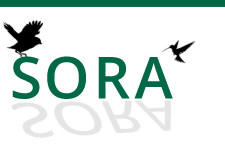Winter Notes from Southern Texas
Online Full Text
Camptostoma imberbe. Examples of the Beardless Flycatcher were secured on January 22, and February 16, 1916, near the Arroyo Colorado (a salt water estuary thirty miles north of the Rio Grande), in the vicinity of Harlingen, Texas. Attention was directed to all individuals recorded, by the characteristic notes of the species, which may be set down az whee-e-oop; often repeated, and distinguishable at a considerable distance. This diminutive bird showed a persistent partiality for the low bushes that constitute the greater portion of the chaparral of the region, never being observed in arborescent growth, although trees grew rather plentifully along the Arroyo, and some large mesquites were scattered through the chaparral proper. This was at variance with my previous experience with the species in Mexico; and it is quite likely that I would have overlooked the bird entirely had its notes not given me the clew. In size, color, and movements, the Beardless Flycatcher bears a superficial resemblance to several other small birds thronging the chaparral during the winter, such as the Verdin, Orange-crowned Warbler, and Ruby-crowned Kinglet.
Bporophila morelleti sharpei. The Seedeater, when surprised and flushed. from its feeding station, arises in a manner suggesting a goldfinch.
(Astragnlinus), and after a short flight alights, rapidly repeating, for several minutes its short-syllabled “clickety” notes. It was seen near Harlingen on January 13 and on many subsequent dates until my departure from the locality on February 28. It seemed to be fond of the soft seeds of a low grass growing among cat-tails that filled the irrigating canals in places. The cat-tails served as a protection to the grass against foraging cattle, as well as from the light freezes that occasionally visited the region. Of the Seedeaters, adults of both sexes, as well as immature males, were secured. This species has generally been supposed to withdraw southward into Mexico, during the winter months.
Anthus spraguei. Another interesting bird, and found in tolerable numbers during January, and up to February 16. A short distance out of the town of Harlingen there is a field of about twenty acres, formerly under cultivation, but which for a year or more had been allowed to grow up in weeds. This growth had been partially cropped by stock, so that the movements of a small bird walking on the ground could be followed for some distance.
It was within this acreage that most of my records for the Sprague Pipit were made. The Common Pipit (Aathus rubescens) was present at times during this period, but the two species were easily distinguished by habits and actions. The Sprague Pipit never assembled in flocks; and the Common Pipit confined itself to recently plowed lands or closely grazed pastures.
Some other species, interesting because of their presence in this locality, are:
Nyctidromua albicollis merrilli, appeared February 8;
Helospiza melodia melodia, one taken January 10;
Melospiza georgiana, several seen January 12;
Peucaeo cassini, numerous after February 16;
Oreospizo chlorura, several noted February 15;
Lanivireo solitarius solitarius, one bird taken January 15.
San Antonio, Texas
Creative Commons License
Recommended Citation
Smith, Austin Paul
(1916)
"Winter Notes from Southern Texas,"
Condor: Vol. 18
:
Iss.
3
, Article 14.
Available at:
https://digitalcommons.usf.edu/condor/vol18/iss3/14

